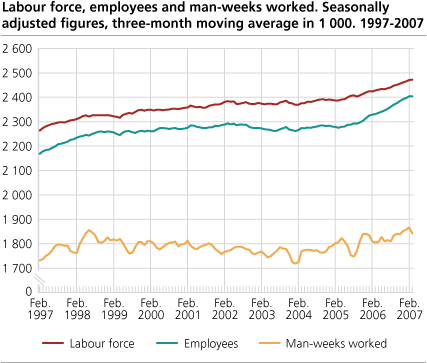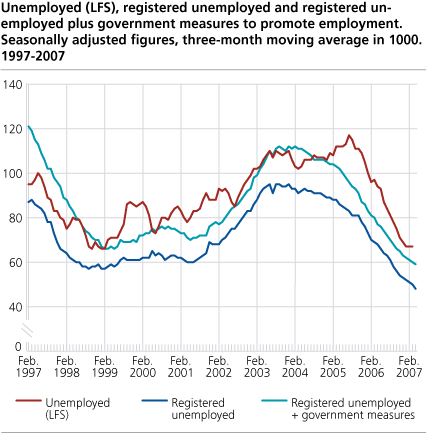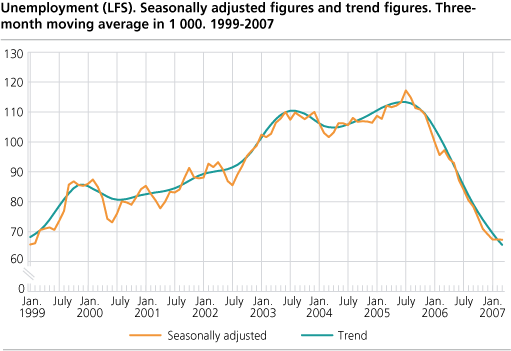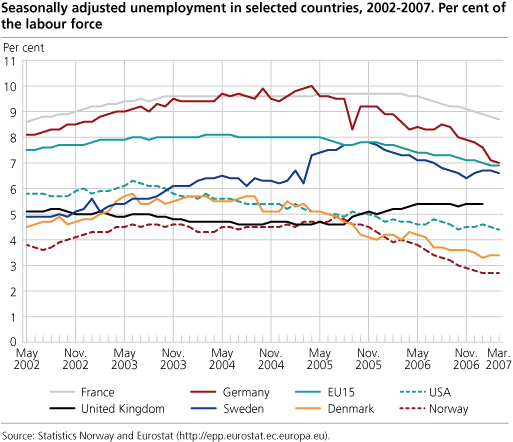Content
Published:
This is an archived release.
Stable unemployment
Both unemployment and employment showed minor changes from December to March according to new, seasonally adjusted figures from Statistics Norway's Labour Force Survey (LFS). The unemployment rate stood at 2.7 per cent in March.
Adjusted for seasonal variations, the LFS shows that the number of employed people increased by 13 000 from December (as measured by the average of the three months from November to January) to March (as measured by the average of the three months from February to April). The increase in employment is lower than the growth in preceding months, and is now inside the error margin.
Unemployment
The unemployment rate stood at 2.7 per cent of the labour force in March (as measured by the average of the three months from February to April), while it was 2.8 per cent in December (as measured by the average of the three months from November to January. The reduction of 0.1 percentage points (or 2 000 people) is inside the error margin. The unemployment rate peaked at 4.9 per cent in mid-2005, and has fallen steadily since. It is now at the same level as the previous low in early 1999.
Seasonally adjusted figures of people registered unemployed with the Labour and Welfare Organisation (NAV), show a decline of 3 000 from December to March.
Man-weeks worked
From December (as measured by the average of the three months from November to January) to March (as measured by the average of the three months from February to April), adjusted for seasonal variations, the average number of man-weeks (37.5 hours) worked each week decreased by 11 000. This reduction is inside the error margin.
Unemployment down in Germany and France
In March, the unemployment rate stood at 7 per cent in Germany, down by 0.8 percentage points from December 2006.In France, the unemployment rate fell from 9 per cent to 8.7 per cent in the same period. The unemployment rate for the EU15 fell from 7.1 to 6.9 per cent. In Sweden, Denmark, and the US the unemployment rate was stable from December to March. (All figures refer to seasonally adjusted data from Eurostat .)
Employment and unemployment only among permanent residents
The LFS only include persons who are registered as residents in the population register. Persons working in Norway, but who are not registered as permanently resident or planning to stay for less than six months, are not included in the number of employed in the LFS. Statistics Norway publishes separate figures for these groups once a year. See also Employment and unemployment among short term immigrants .
Uncertain figures
The purpose of making adjustments for seasonal variations is to describe the development over the last year and provide estimates of change between the last two three-month periods, corrected for normal seasonal variations. In order to reduce uncertainty, the published series are three-month moving averages of the seasonally adjusted figures. For instance, the figures for February represent the average of the estimates for January, February and March.
Quarterly LFS figures, not seasonally adjusted, are presented in a separate article .
Tables:
The statistics is published with Labour force survey.
Contact
-
Arbeidsmarked og lønn
E-mail: arbeidsmarked@ssb.no
-
Erik Herstad Horgen
E-mail: erik.horgen@ssb.no
tel.: (+47) 93 08 68 62





